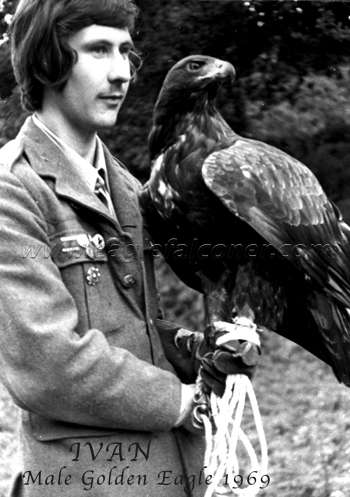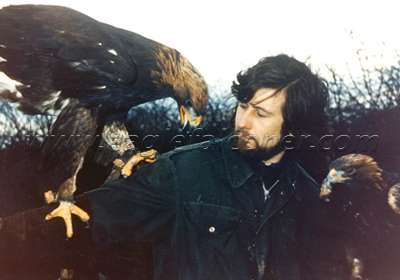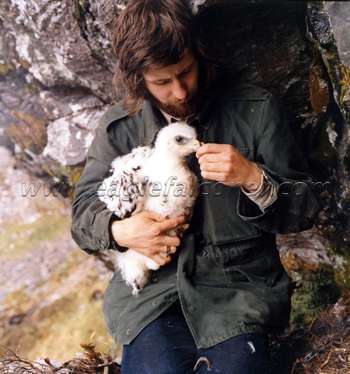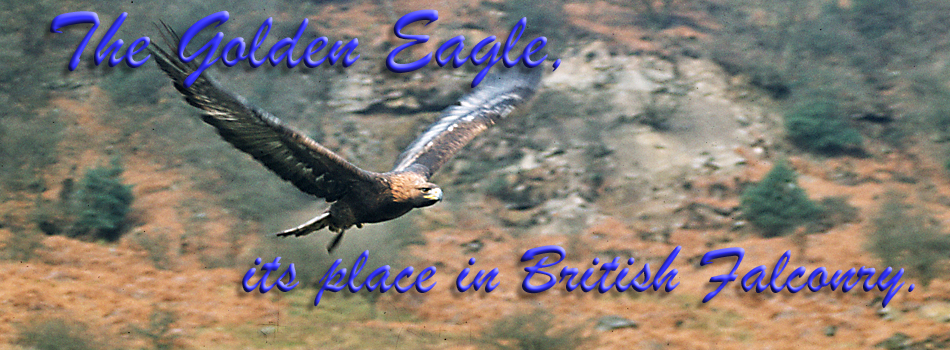 The Golden Eagle is undoubtable one of the most magnificent raptors ever trained for the art of falconry. This is a fact that is rarely appreciated by the great majority of British falconers, although the Golden Eagle is today successfully flown by more falconers than at any time in British falconry history. The Golden Eagle is undoubtable one of the most magnificent raptors ever trained for the art of falconry. This is a fact that is rarely appreciated by the great majority of British falconers, although the Golden Eagle is today successfully flown by more falconers than at any time in British falconry history.
It is strange that such a large and potentially capable raptor should finally find success in todays modern world.
Britain is a crowded island, with a human population of some fifty five million squeezed into eighty eight thousand square miles, there is little room left for wide open wild and remote landscape really needed to fly a Golden Eagle.
For centuries the trained Golden Eagle was greatly prized in Central Asia, and although the art of training eagles was introduced into Europe by the returning Crusaders it was never taken seriously by the English.
In the thirteenth and fourteenth centuries the odd eagle was presented to Royalty from the Muscovite Emperors, unfortunately the British Royalty seem not to have been interested in eagles as trained hunting birds.
Not until the middle of the nineteenth century is there any record of a serious attempt in Britain to train a Golden Eagle. Captain Green, of Buckden, in Huntingdonshire trained and flew an eagle at hare and rabbits. It was taken into the field on a perch carried by two men, but its great weight and the difficulty of keeping it keen, due to its powers of fasting made it too troublesome for the Captain to manage.
This lack of understanding on both obtaining and maintaining a large eagle in condition, together with a non-intuitive approach towards handling and training, seems to be at the root of the derogatory attitude towards the Golden Eagle that was held by many up until recent times.
The basic training methods of shortwinged hawks was inherently flawed and the problem was only  exasperated when applied to eagles. Most falconers, and some still do, treated Golden Eagles as large goshawks, feeling that due to their greater size and strength would be well able to deal with large brown hares weighing eight pounds and more. This is true, but coupled with their lack of ability in maintaining an eagle in condition, a nd in the majority of cases flying these same eagles over large areas of flat terrain, only increased their reputation of a slow laboured lack lustred style. exasperated when applied to eagles. Most falconers, and some still do, treated Golden Eagles as large goshawks, feeling that due to their greater size and strength would be well able to deal with large brown hares weighing eight pounds and more. This is true, but coupled with their lack of ability in maintaining an eagle in condition, a nd in the majority of cases flying these same eagles over large areas of flat terrain, only increased their reputation of a slow laboured lack lustred style.
Captain C.W.R. Knight was a well known falconer, naturalist, author, film maker and showman. In 1926 he obtained a female Golden Eagle eaglet with the intention of training her for falconry. Using the standard training methods of the day whereby repeated calling to the fist for a mouthful of reward and forceable removing the remaining tidbit, taught the female upon landing to grab Knight’s right hand as he attempted to remove her reward. His answer to this was to fit the eagle with larger jesses to enable him to get a tighter grip thus hoping to prevent her reaching out at his approaching hand.
Eagles learn very fast, and learn to anticipate a repeated action before it is performed, soon upon landing she would lash out at the first thing that moved, his face, with the serious consequences that entailed, Knight decided to release her to the wild.
 The following year he obtained a second female eaglet from London Zoo, trained her exactly as the first and within months had the same results. He returned this one to the Zoo and came away with her brother. The following year he obtained a second female eaglet from London Zoo, trained her exactly as the first and within months had the same results. He returned this one to the Zoo and came away with her brother.
Mr. Ramshaw as the eagle was subsequently named was treated with more respect than the first two females, although Knight still forcibly removed the eagles food he was surprised that the eagle showed little resentment towards him.
Knight the author recounted these events in a number of books and liked to dwell on the numerous mauling’s he received from these two female eagles, with the end result blackening the temperaments of female golden eagles for a great many years to come.
The damage Knight had done to the reputation of female eagles was perpetuated by many authors extolling the art of falconry in book form. They would, upon listing the various species of birds of prey suitable for the hunt, usually leave the eagle until last. Then recount a catalogue of disaster that befell some poor unfortunate who had been foolish enough to attempt to train this most unpredictable and ferocious of birds. These stories usually ended with the poor owner at his wits end, giving the eagle to a zoo or menagerie. The writer who had probably never encountered an eagle, warning the reader never to be tempted for what ever reason.
Less well known at the time than C.W.R.Knight, but probably the first successful eagle falconer in Britain was William Humphrey , Lord of the Manors of Skelton-le-dale and Ratlinghope, Shropshire, and one of the leading figures in British fields sports.
He was world famous for his breeding and training of English Setters, the Laverack-Llewellin strain of which he preserved with jealous care, many winners of Field Trials were exported to America.
Humphrey was flying golden eagles from the 1920’s to the late 50’s, and was training he last female eagle “Lady Ben Nevis” in his seventies.
Humphrey flew mostly at red foxes and was very successful indeed, ‘With one female eagle he had taken three adult foxes in a day , eight in a week...eighty with one bird, about thirty with another female and twenty with a male.
Success was helped by the fact that Humphrey worked his eagles with dogs, two terriers and a Llewellen setter. A remarkable feat indeed working an eagle on foxes and managing to keep the eagles respect towards the dogs especially the terriers as equal hunting partners and not potential quarry.
A most unusual factor was Humphrey trained his eagles to return and to be carried on his shoulders which were protected by heavy horse hide, even though when sharp set he remarked that the eagle could numb his shoulders with her grip.
Although little is reported as to his initial training methods, they must have been more sympathetic towards the eagles temperament to allow a returning fox hunter to land on you shoulders without serious risk to your personal safety.
It was not until Jack Mavrogordato wrote the definitive ‘A Hawk for the Bush’ in 1960 in which he reiterated the advice of Lt.-Col.Delme-Radcliffe first published in his ‘Notes on the Falconidae used in India in Falconry’ around 1870, that training methods changed for the better, both for shortwings and subsequently eagles.
I quote the following :
“Most falconers make the mistake with goshawks both when training them, and by way of exercising them when they are trained, of calling a hawk repeatedly to the fist, giving her a bite of food each time, and then putting her down and calling her up again and again, this being often done with washed meat as a reward. Hawks so treated are quite certain to be slack at coming out of a tree, as they have learnt to come for a present reward, which reward they don’t care very much about. But goshawks ought to come to their master’s hand whenever called by him, under a certainty of getting no reward at the time. This is to be arranged by carefully avoiding ever deceiving them by such practices as above mentioned. If it should appear desirable to give washed meat, give it to them, but do not call them to you to receive it. After goshawks have once learnt to come to the fist at all, they ought never to be called more than twice in each meal during their training, and the distance should be increased every day, discretionally, until they will come at least 1000 yards, always on such occasions being rewarded with some newly-killed bird, warm, and a bird they like too, as a wild duck or partridge.
Thus they will grow fond of their master, and after a successful flight or two from his hand, will be ever on the look out to be with him, never expecting food for merely coming a few yards, whether at home or in the field.
Very different is the case with hawks which, having taken stand after a long flight, have recollections of sodden meat, which hunger compelled them to want, often torn from them by force again and again, by way of teaching them to come freely to the hand while being trained, and which afterwards in the field are always called to the fist by a show of a piece of meat, to be immediately snatched away on their alighting; they sit and look and think about it.”
Sound advice indeed, and all the more incredible that it was first published in 1870.
During the 1960’s a new breed of eagle falconers were quietly enjoying excellent sport, Rob Allan of  North Wales, John Hockenhull of Cheshire and Lorent de Bastyai of South Wales. Who between them were flying well behaved male and female Golden Eagles at rabbit ,hare and foxes. North Wales, John Hockenhull of Cheshire and Lorent de Bastyai of South Wales. Who between them were flying well behaved male and female Golden Eagles at rabbit ,hare and foxes.
In 1969 I was offered an adult male Golden Eagle, at that time I lived in the Channel Islands on my native island of Jersey situated in the English Channel just off the coast of Northern France.
It was not the most suitable of places to fly an eagle, but the western coast of the island offered an area of approximately four square miles of rolling sand dunes, together with the northern headlands above the sea cliffs I was to witness an eagles true natural flying ability.
These headlands were steep, bracken and bramble covered slopes about two hundred yards wide and a few miles long. The main quarry was the rabbit, with almost total cover they were a wily adversary. ‘Ivan’ the male eagle adapted a technique which was both exciting and successful. Using the natural up-draft from the cliffs he would ride backwards and forwards, as I struggled through the bracken beating the most likely looking places. If anything moved, near me or ahead he would sail across and above the spot, roll over, close his wings and stoop, punching his way through the dense cover to grab a rabbit.
When I moved to mainland Britain a successful slope soaring eagle that was capable of taking large brown hares in style interested a good number of austringers.
Through invitation I was able to fly my male eagle at rabbit, brown and blue hare over a varied terrain throughout Northern England and Scotland.
In 1972 The Scottish Home Office granted the first licences to take Golden Eaglets from the Highlands of Scotland, this continued for about ten years enabling those falconers who were tempted to try a high-flying eagle to apply for a licence.
This was undoubtedly the most significant period in establishing the Golden Eagle as a serious hunting partner in British Falconry. From the wild population of some four hundred pairs, an annual take of five or so eaglets had no detrimental effect on the population. In fact an agreement was made by licensees to only take from two eaglet eyries, thus leaving the parent birds with the remaining eaglet and the bond with that eyrie as a successful site for future use. It also offered a unique opportunity to select the sex of the eaglet required, in most cases a male eagle is more than adequate for most quarry to be flown in the U.K.
Sadly the right to apply for a licence to take an eaglet from the wild was revoked after pressure from ornithological organisations. The authorities deciding that with a captive population of some fifty Golden Eagles in the U.K. this was a large enough gene pool, and should be exploited through domestic breeding to sustain the demand from falconers for eagles to train.
This luxury of sex selection is not available today with domestic breeding, the much larger and bolder females are not always desirable, depending on the terrain and quarry available to the falconer.
 Back in the early seventies, social imprinting of wild taken eaglets was not generally understood, the main criterion was at all cost to prevent a screamer, this coupled to a greater respect when handling an eagle with food, produced some very acceptable hunting eagles. Back in the early seventies, social imprinting of wild taken eaglets was not generally understood, the main criterion was at all cost to prevent a screamer, this coupled to a greater respect when handling an eagle with food, produced some very acceptable hunting eagles.
Accounts and articles in the falconry club journals and newsletters of some spectacular eagle falconry, began to appear on a regular basis, mostly of high-flying eagles as they do seem to emphasise the meaning of spectacular.
The stoop of a Golden Eagle from a large height of a 1,000 feet or more, is an event one rarely forgets. As the large bird folds into the teardrop stoop one senses an excitement as this silent natural missile plummets earth wards.
Neck craning skywards you are aware that you have momentarily stopped breathing, and the rhythmic beating of your heart sounding in your head is being assaulted by an air ripping sound as the stooping eagle nears four hundred feet from the earth.
The velocity of this feathered missile seems to have greatly increased as the air screams through the slit in the single leg bell. At one hundred feet the eagle starts to level out of the stoop cutting across the top of heather clad hill at about ten feet she closes in on a fleeing hill hare.
This input of positive recounting of events confirmed that the Golden Eagle was now a serious contender for the experienced falconer.
The list of regularly taken quarry was increasing, no longer just the humble rabbit and the athletic brown hare. Now the blue mountain hare which is a more traditional quarry of our wild eagles in the Highlands of Scotland was ending up in the falconer’s bag. Red Foxes too, a very formidable quarry, wily and very fleet of foot, armed with a ferocious set of teeth. A wise eagle falconer uses only an experienced sure footing eagle to tackle the fox, if taken out on the open hill rathe r than just bolted from an earth it is a worthy quarry.
Roe and Sika deer were taken on the hill, although the Sika when fully grown can weigh from 100 lbs upwards, I have only known of the odd Sika taken and killed by a trained eagle.
The roe is a much more suitable deer quarry and if taken by a high flying eagle producing a spectacular flight culminating in a satisfactory end.
Roe hawking on the flat tends to result in a rodeo come drag em down scenario, whereas a high flying eagle out on the hill stooping from a few hundred feet can kill an adult roe.
My female Golden Eagle ‘Maria’ with now twenty three hunting seasons to her credit proved this point on the second deer she tackled. Stooping at a shallow angle of about 35 degrees across the hill, from a height of no more than two hundred feet and at a distance of about half a mile. She took a roe doe weighing 52 lbs by the head, the impact threw the doe forward and head over heals with the eagle still binding to the head resulting in a broken neck for the doe.
Winged quarry has been taken on occasions, here I am only concerned with stylish flying encounters . I have not been able to achieve anything other than the occasional and opportunist kill on wing quarry, hill pheasants mostly, never have I taken a red grouse, although I have heard of the odd one being plucked from the heather.
The following is an account of my male eagle ‘Ivan’ who was invited to a days rabbit hawking on the hills of the North Yorkshire moors by the landowner and his keeper.
“ He caught two more rabbits before we decided to call it a day. As we made our way diagonally down the hill, John the keeper virtually stood on a cock pheasant, it burst into action, its verbal cacophony was still ringing in my ears as I saw ‘Ivan’ close his wings and start to plummet earth wards.
Now, he rarely takes any notice of feathered quarry, and I had informed our host of this matter with almost certainty.
‘Ivan’ had commenced his stoop some fifty yards behind us and it was near vertical, perhaps he had seen a rabbit, the old cock was now cracking on ahead. My companions were still watching the departing pheasant, ‘Ivan’ levelled out of his dive and passed between Morris and I at about shoulder height. With wings still tucked tight to his body he past like a cruise missile. I saw Morris flinch at the sound of the parting air. He overhauled the pheasant in a couple of seconds, and as he came level, he rolled over onto his side and we saw a large yellow foot, reach out and pluck the pheasant out of the air. He then turned into the hillside and landed.
I was speechless, then Morris whooped out and yelled ‘BRILLIANT’. I apologised. ‘Sorry?’ he yelled “That was the best yet, I’ve never seen anything like it. What a brilliant day’.
In twenty seven years of memories flying Golden Eagle, few could be described as dull and lack lustre. The British falconer has at long last discovered the enormous potential of the Golden Eagle.
Everett, Mike., 1992.The Golden Eagle. The Falconers & Raptor Conservation Magazine. 10:6-7
Gates, A. 1989. They Call the Wind Maria. The Austringer 89: 2-5.
Gates, A. 1990. Call of the Wind. The Falconers & Raptor Conservation Magazine. 4: 8-10 Gates, A. 1991. A Day on the Hill. The Falconers & Raptors Conservation Magazine. 7: 14-15.
Harting, J.E., Hints on the Management of Hawks. The Tabard Press Ltd. London 1970
Illingworth, F., Falcons and Falconry. Blanford Press. London. 1971.
Knight, C.W.R., All British Eagle. Hodder and Stoughton Ltd., London. 1943.
Knight, C.W.R., The Book of the Golden Eagle. Hodder and Stoughton Ltd. London. 1927
Mavrogordato, J.G., A Hawk for the Bush. H.F. & G. Witherby Ltd. London. 1960 |
